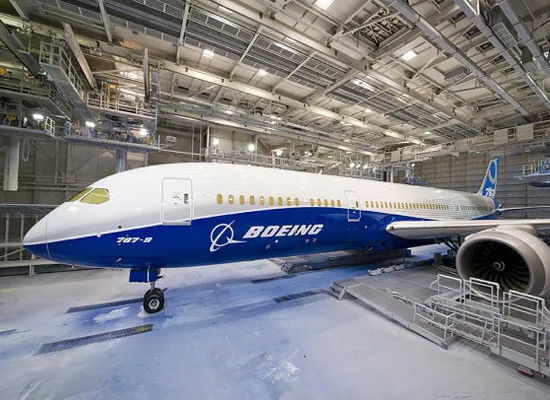
Boeing 787-9 - first pictures
Jul 26, 2013

The Boeing 787-9, an advanced long-haul aircraft, showcases a sleek design that emphasizes efficiency and passenger comfort. Its first pictures reveal a graceful silhouette, featuring a longer fuselage than its predecessor, the 787-8. The aircraft is notable for its innovative use of composite materials, which contribute to reduced weight and improved fuel efficiency. Large, sweeping windows provide passengers with stunning views and a more spacious feel. Inside, the cabin is designed with modern amenities, offering a quieter and more comfortable flying experience. The 787-9 represents a significant step forward in aviation technology and design, setting new standards for air travel.
The Boeing 787-9, an impressive member of the Dreamliner family, has captured the attention of aviation enthusiasts and professionals alike. Known for its fuel efficiency and innovative design, the 787-9 offers a range of features that enhance both passenger comfort and operational efficiency. In this article, we will explore the first pictures of the Boeing 787-9, along with key specifications and details that make this aircraft a standout in the aviation industry.
Stunning First Pictures of the Boeing 787-9
The initial images of the Boeing 787-9 highlight its sleek fuselage and cutting-edge wing design. These pictures showcase the aircraft's modern aesthetics and engineering marvel, making it an eye-catching addition to any fleet. The 787-9's extended wingspan and distinctive raked wingtips not only contribute to its striking appearance but also play a crucial role in improving aerodynamics and fuel efficiency.
Key Specifications of the Boeing 787-9
Understanding the specifications of the Boeing 787-9 is essential for anyone interested in aviation technology. Below is a table summarizing the key features of this aircraft:
| Specification | Details |
|---|---|
| Length | 206 feet 1 inch (62.8 meters) |
| Wingspan | 197 feet 3 inches (60.1 meters) |
| Maximum Takeoff Weight | 560,000 pounds (254,000 kg) |
| Cruising Speed | Mach 0.85 |
| Range | 14,140 kilometers (7,530 nautical miles) |
| Seating Capacity | Up to 296 passengers (typical two-class configuration) |
These specifications underline the Boeing 787-9's capability to serve long-haul routes efficiently while providing a comfortable flying experience for passengers. Its advanced materials and construction techniques contribute to its lightweight structure, allowing for greater fuel savings and reduced emissions.
Innovative Features of the Boeing 787-9
One of the standout features of the Boeing 787-9 is its use of composite materials, which make up approximately 50% of the airframe. This not only reduces the overall weight of the aircraft but also enhances its resistance to corrosion. Additionally, the 787-9 boasts state-of-the-art engines that provide significant fuel efficiency benefits, allowing airlines to operate more sustainably.
Another remarkable innovation is the cabin environment of the Boeing 787-9. Passengers can enjoy larger windows that can be electronically dimmed, allowing for a more pleasant flying experience. The cabin is designed to maintain lower altitude pressure, which helps reduce passenger fatigue and enhances overall comfort during long flights.
Operational Efficiency and Sustainability
The Boeing 787-9 is designed with operational efficiency in mind. Its advanced aerodynamics and engine technology result in up to 20% lower fuel consumption compared to similar-sized aircraft. This not only translates to cost savings for airlines but also aligns with the industry's push towards more sustainable aviation practices.
As airlines face increasing pressure to reduce their carbon footprints, the Boeing 787-9 serves as a viable solution. Its efficiency helps operators meet regulatory requirements and consumer demand for greener travel options.
Market Impact and Popularity
Since its introduction, the Boeing 787-9 has gained popularity among airlines worldwide. Its versatility allows it to serve a variety of routes, from short-haul to long-haul operations. Major airlines have embraced the 787-9, integrating it into their fleets to enhance passenger experience and operational efficiency.
The demand for the Boeing 787-9 has also led to a robust market presence, with numerous orders placed by airlines globally. This aircraft's ability to connect distant markets with reliable service makes it a favorite choice for international travel.
Conclusion
In summary, the Boeing 787-9 is a remarkable aircraft that combines cutting-edge technology with passenger comfort and operational efficiency. The first pictures of the Boeing 787-9 reflect its modern design and innovative features, while its specifications highlight its capabilities as a long-haul aircraft. With a focus on sustainability and performance, the Boeing 787-9 represents the future of aviation. For aviation enthusiasts, professionals, and travelers alike, this aircraft is a testament to what can be achieved through engineering excellence.
As the aviation industry continues to evolve, the impact of the Boeing 787-9 will undoubtedly be significant, shaping the way we think about air travel for years to come.
Related Articles

Explore Thailand: The Best Islands to Visit for Paradise, Adventure, and Relaxation

The Ultimate Guide to the Best Islands in Thailand for Your Next Getaway

Do babies need passports? How to get a passport for a newborn

How to get a U.S. passport fast: here’s how to expedite the process

What is Mobile Passport Control: 5 reasons why you should use it

SENTRI vs. Global Entry: A detailed guide

Do you need a passport to go to the Bahamas? Let’s find out

Do you need a passport to go to Mexico? A detailed guide

Do you need a passport to go to Canada? We got the answer

Do You Need a Passport for a Cruise: An Essential Travel Guide

Booster Seat Requirements: All the Rules to Follow in Your Rental Car

What Are the World’s Most Powerful Passports, and How Does Yours Rank?

How to Take a Passport Photo at Home: A Helpful Guide

You've got to have heart! Southwest's new livery

Your opinion: Should water be free on low cost carriers?

Young women bolder than guys as solo travellers
